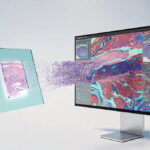The Value of the Cloud
The creation, use, storage, and exchange of healthcare data have all changed dramatically. The healthcare business has gone a long way in terms of refining its data management processes, from traditional storage to digitization of healthcare data.
The healthcare business, which has typically trailed behind its peers in terms of cloud adoption, is now leading the pack. According to research by West Monroe Partners, 35% of healthcare firms questioned had more than 50% of their data or infrastructure in the cloud. When compared to other businesses, healthcare has been the slowest to adopt cloud technology.
Cloud computing’s growing acceptance in healthcare extends much beyond simply storing data on cloud infrastructure. Healthcare providers are currently utilizing this technology to increase efficiencies, streamline processes, minimize healthcare delivery costs, and enable personalization in treatment plans to enhance results. Cloud usage is gaining traction in a variety of areas, including healthcare. According to Worldwide Industry Insights, the cloud computing market in healthcare hit $8.5 billion in 2018, with the global total expected to reach $55 billion by 2025.
How Cloud Computing Is Transforming the Healthcare Industry
There are two major advantages of using the cloud. It is beneficial to both healthcare practitioners and patients. From a commercial standpoint, Cloud computing aids in the reduction of operating costs. It allows clinicians to provide high-quality, tailored treatment while still lowering costs.
As patients get access to their healthcare data, moving to the cloud enhances patient involvement with their own health plans. As a result, cloud technology enhances patient outcomes.
The democratization of healthcare data and its remote accessibility liberates both clinicians and patients, removing geographic obstacles to healthcare.

Here Are the Ways Cloud Computing is Impacting Healthcare
1. Cost-cutting
Cloud computing is based on the availability of computer resources such as data storage and processing power on demand.
The requirement for hospitals and healthcare organizations to acquire hardware and servers altogether is eliminated.
There are no upfront costs connected with data storage in the cloud. You just pay for the resources you utilize, resulting in significant cost savings.
In addition, cloud computing provides the most ergonomic environment for scalability, which is a desirable attribute in today’s world.
With patient data streaming from a variety of sources, including EMRs and EHRs, HIS, Labs, healthcare applications, and health wearables, a cloud-based system is ideal for expanding and undergoing significant upgrades while keeping costs down.
2. Interoperability Ease
Interoperability strives to create data interconnections across the healthcare system, regardless of where the data originates or is stored. Patient data is easily available for dissemination and generating insights to enhance healthcare planning and delivery as a result of interoperability, which is supported by cloud use.
Cloud computing enables healthcare practitioners to easily access patient data gathered from a variety of sources, communicate it with key stakeholders, and provide prescriptions and treatment procedures on time. It also reduces the distance between professionals, allowing them to analyze situations and provide comments regardless of geographical constraints.
Interoperability across the many components of the healthcare industry—pharmaceuticals, insurance, and payments—is also facilitated by storing patient data in the cloud. This enables the smooth movement of data between the many stakeholders, hence speeding up healthcare delivery and increasing efficiency.
3. Access to Advanced Analytical Tools
Healthcare data, both organized and unstructured, is a tremendous resource. In the cloud, relevant patient data from many sources may be gathered and calculated. Medical research can be boosted by using Big Data analytics and artificial intelligence algorithms on cloud-stored patient data using a Medical Tablet. Processing huge datasets become more viable because of the cloud’s enhanced computational capability.
Analyzing patient data can also lead to the development of more individualized care plans for patients on an individual basis. It also guarantees that all-important patient information is recorded and that nothing is overlooked when prescribing treatment. You can click here to understand how an ERP software can help manage cloud computing to operate your processes.
4. Data Ownership by The Patient
Cloud computing decentralizes data and empowers individuals to make decisions about their own health. By functioning as a tool for patient education and engagement, it increases patient participation in health-related choices and leads to more informed decisions.
When putting data in the cloud, patient information and medical imaging may be conveniently saved and accessed. While cloud security remains a worry, cloud data storage dependability is unquestionably greater. With increased system uptime, data redundancy is decreased. Data recovery is easier because the backups are automatic and there isn’t a single touchpoint where the data is saved.
5. Capabilities in Telemedicine
The ability to retrieve data from a distance is one of the most significant benefits of cloud storage. The marriage of cloud computing with healthcare offers the potential to enhance telemedicine, post-hospitalization care planning, and virtual drug adherence, among other healthcare-related services. Telehealth enhances access to healthcare services as well.
Telemedicine applications make healthcare delivery more convenient while also improving the patient experience. Cloud-based telehealth systems and applications enable simple data exchange, improved accessibility, and healthcare coverage for patients during the prevention, treatment, and recovery phases.
Obstacles to Cloud Computing Adoption in Healthcare
1. Concerns about security
The most significant impediment to cloud adoption in healthcare is the potential security risk. Patient data is inherently sensitive, and cloud-hosted healthcare data must be protected from outside attacks. Some of the ways healthcare businesses may maintain the security of sensitive patient data kept in the cloud include data encryption, the use of security keys for access, and the usage of blockchain for data security.
2. Security Norms Observance
A variety of data regulatory rules, including HIPAA, HITECH, and GDPR, apply to healthcare data and associated applications. This also applies to data stored in the cloud. When going to the cloud, healthcare providers must ensure that the data held there is compliant.
3. System Unavailability
While the cloud provides more stability, downtimes are unavoidable. You can overcome any downtime if you have contingency planning in place and are prepared for a probable failure. When developing cloud apps, designing for failure is recommended as a best practice. In the healthcare industry, cloud computing still has a long way to go. Its use in conjunction with fast-expanding technology like Big Data analytics, artificial intelligence, and the internet of medical things enhances efficiency and expands the number of ways to streamline healthcare delivery. It improves resource availability, improves HIE interoperability, and reduces costs. There’s no excuse not to go cloud with so many advantages and plans in place to handle the obstacles!
Did you find this helpful? Check out our other helpful articles on our website.
Read Also
- Automated Healthcare Software Solutions: How Intelligent Platforms Are Redefining Clinical, Administrative, and Operational ExcellenceThe healthcare industry is undergoing a seismic transformation. Rising patient volumes, value-based care models, staffing shortages, and complex regulatory demands have prompted organizations to look beyond traditional tools and embrace advanced software automation. As providers search for innovative partners capable of tailoring these sophisticated systems to real-world workflows, many turn to MCSI (Managed Care Systems,… Read more: Automated Healthcare Software Solutions: How Intelligent Platforms Are Redefining Clinical, Administrative, and Operational Excellence
- Why Whole Slide Imaging Shapes the Future of Digital PathologyWhole slide imaging has become one of the most important developments in modern pathology. It changes how tissue is examined, how cases are shared and how pathologists collaborate with the wider care team. More than a technological upgrade, it represents a shift in how laboratories think about their workflow, their storage needs and the tools… Read more: Why Whole Slide Imaging Shapes the Future of Digital Pathology
- Comparing 2025 Dental Practice Management Software OptionsSoftware Key Strengths Potential Limitations Best For Dentimax • Offers both cloud-based and on-premise/server deployment. • Tight integration between imaging (e.g. X-ray sensors) and practice management, charts, treatment planning, imaging all in one. • Transparent pricing and relatively simple UI/usability; solid for small to medium general practices. • May lack some of the… Read more: Comparing 2025 Dental Practice Management Software Options
- Top Innovations in Dermatology and Skincare TechnologiesHave you ever wondered how skincare keeps getting better year after year? From fighting acne to reducing wrinkles, today’s treatments seem more advanced than ever before. The tools and techniques used by dermatologists today are smarter, safer, and more effective than those we had just a few years ago. These breakthroughs don’t just help with… Read more: Top Innovations in Dermatology and Skincare Technologies
- Telehealth and Beyond: Building a Connected Continuum of CareHealthcare is on the verge of a radical transformation. Technology no longer simply supports medicine; it actively shapes how care is delivered and experienced. Achieving a seamless continuum demands more than deploying tools—it requires intentional design, coordinated teamwork, and innovative platforms that adapt to diverse clinical and patient needs. This article explores key strategies for… Read more: Telehealth and Beyond: Building a Connected Continuum of Care
- Optimizing CT Protocols: The Hidden Key to Efficiency and Cost Savings in RadiologyIntroduction: Why CT Protocol Optimization Matters Computed Tomography (CT) is a cornerstone of modern diagnostic imaging, providing critical information across nearly every medical specialty. However, maximizing the value of CT — both clinically and financially — requires more than just advanced hardware. The real secret lies in the optimization of CT protocols. When CT protocols… Read more: Optimizing CT Protocols: The Hidden Key to Efficiency and Cost Savings in Radiology
- The Role of Carbide Burs in Modern Dental ProceduresAs a result of this procedures need to be well coordinated and to this end, precision tools are used by dental practitioners. Among the most essential tools in a dentist’s arsenal are carbide burs, which have revolutionized various aspects of dental work. Today’s dentistry cannot work without these tools as they are both strong, sharp,… Read more: The Role of Carbide Burs in Modern Dental Procedures
- Detection of Diabetic Retinopathy: The AI AdvantageDiabetic retinopathy (DR) is a leading cause of blindness among working-age adults, affecting millions worldwide. The prevalence of DR is alarmingly high, affecting an estimated 34.6 million people globally. In the United States alone, it is estimated that 7.7 million adults have some form of diabetic retinopathy. How Does Diabetes Affect the Eye? Most of… Read more: Detection of Diabetic Retinopathy: The AI Advantage









